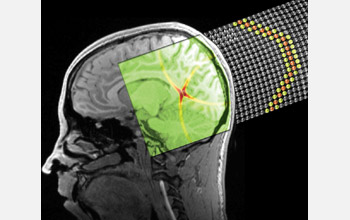Multimedia Gallery
Sound Bullet
Potential employment of a nonlinear acoustic lens to generate a sound bullet for hyperthermia procedures. The colored spheres depict nonlinear acoustic waves traveling within sphere chains. The curvature of the wavefront is induced by precompressing each row, and is used to generate appropriate time delays to focus acoustic energy at a desired focal point. The stylized image depicts a sound bullet superimposed onto a brain MR image provided by Mike Tyszka of the California Institute of Technology Brain Imaging Center.
The nonlinear acoustic lens was developed by Chiara Daraio, assistant professor of aeronautics and applied physics at Caltech, and postdoctoral scholar Alessandro Spadoni. The lens and its sound bullets have the potential to revolutionize applications from medical imaging and therapy to the nondestructive evaluation of materials and engineering systems.
To learn more about this research, see the Caltech press release,
"Caltech Researchers Create 'Sound Bullets.'" [Research supported by National Science Foundation grant CMMI 08-44540.] (Date of Image: 2010)
Credit: Spadoni and Daraio/Caltech
Images and other media in the National Science Foundation Multimedia Gallery are available for use in print and electronic material by NSF employees, members of the media, university staff, teachers and the general public. All media in the gallery are intended for personal, educational and nonprofit/non-commercial use only.
Images credited to the National Science Foundation, a federal agency, are in the public domain. The images were created by employees of the United States Government as part of their official duties or prepared by contractors as "works for hire" for NSF. You may freely use NSF-credited images and, at your discretion, credit NSF with a "Courtesy: National Science Foundation" notation.
Additional information about general usage can be found in Conditions.
Also Available:
Download the high-resolution JPG version of the image. (460 KB)
Use your mouse to right-click (Mac users may need to Ctrl-click) the link above and choose the option that will save the file or target to your computer.

